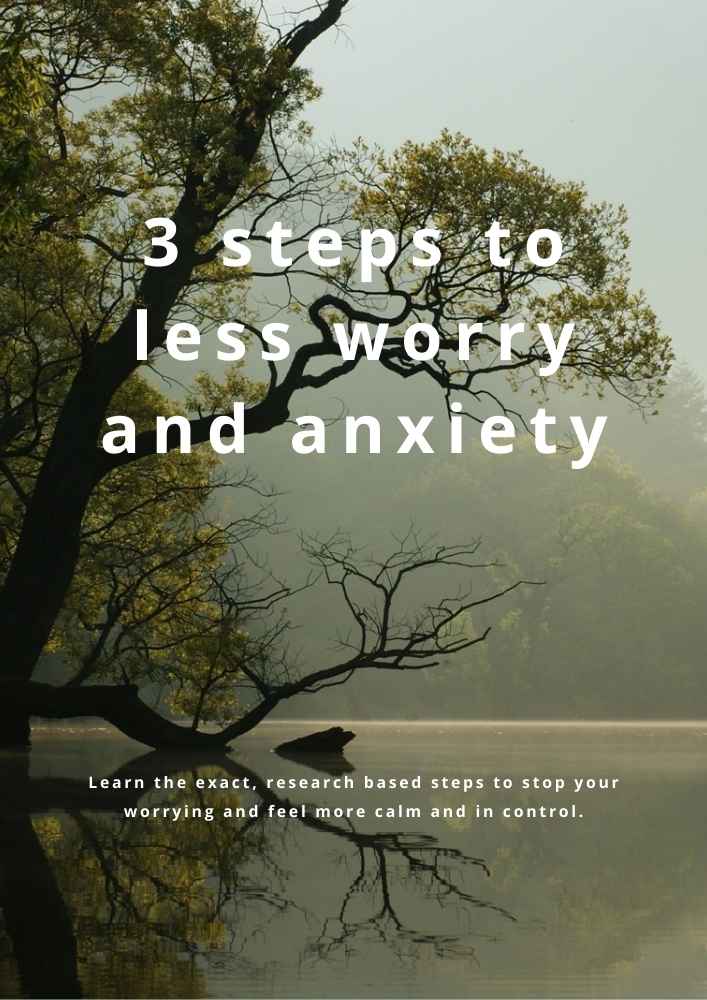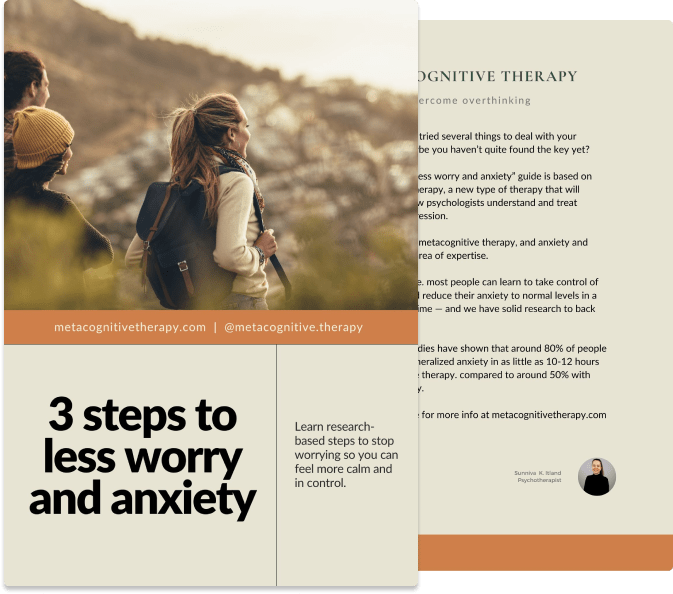Struggling with social anxiety? This shift can completely change how you show up in social situations

Download our best tips on reducing anxiety and worrying
Learn three powerful metacognitive therapy steps to stop the worry cycle, reduce anxiety, and feel calmer in everyday life.
.jpeg)
.jpeg)
If you’ve ever walked away from a conversation replaying every single word, or felt your mind go blank the second it’s your turn to speak, you’re not alone.
Social anxiety is one of the most common forms of anxiety, but you can find calmness and confidence with the right shifts in your approach.
Social anxiety can show up in a few different ways: Some people feel intense anxiety in the moment (heart racing, mind blanking, and an overwhelming fear that everyone can see them panic). Others feel comfortable during the social event, but afterwards they spend hours (or even weeks) ruminating on how they showed up, critiquing what they said, and worrying about how they were perceived. For some, both experiences overlap.
Let’s dive into how you can navigate social anxiety that feels strongest during social interactions.
Why social situations feel stressful
For many people with social anxiety, the most difficult experiences aren’t necessarily with strangers or close friends, but with acquaintances like colleagues, classmates, or people they see regularly on a casual basis. The stakes feel higher: because you’ll see these people again, you want to make a good impression.
What often happens in these moments is a shift in focus. Instead of naturally paying attention to the conversation and other person, you become hyper-aware of yourself, monitoring your every move: Is my voice shaking? Do I sound stupid? Am I blushing? Is my body language awkward?
This intense self-monitoring doesn’t help you communicate better — it actually makes it harder to think clearly, follow the conversation, or pick up on social cues. You’re leaving little room for actual social interaction, so the strategies you use to manage your anxiety can have the adverse effect of making you seem distant or distracted, and ultimately less likeable.
The cost of coping strategies
People who experience social anxiety often develop strategies to “manage” their symptoms in the moment, but these strategies usually backfire.
Some try to control how their anxiety shows up: avoiding eye contact, talking faster to avoid more attention, over-preparing what they’ll say, or physically hiding signs of nerves (like masking blushing with makeup). Others try to avoid situations that might trigger discomfort altogether.
These approaches often reinforce the belief that you can’t handle social situations without controlling your symptoms or experience. This ultimately creates a cycle: the more you rely on these strategies, the more anxious you feel, and the more reliant you are on these strategies for the next time.

Download our best tips on reducing anxiety and worrying
Learn three powerful metacognitive therapy steps to stop the worry cycle, reduce anxiety, and feel calmer in everyday life.
The cycle of pre- and post-worrying
Social anxiety rarely starts and ends in the moment. You might spend significant time worrying before social interactions, mentally rehearsing conversations, picturing every detail of the interaction, and trying to prepare for every possible outcome.
Then, after the event, rumination takes over. You replay moments, criticize yourself for being awkward, and think of what you “should” have said. These habits actually increase the stress and anxiety of future interactions.
What’s at the root of social anxiety?
A common misconception about social anxiety is that it stems from negative self-beliefs, like thinking you’re boring, awkward, or unlikeable. The truth is, most people have these thoughts from time to time, but for most, it doesn’t automatically create anxiety.
The difference isn’t the thoughts themselves, it’s how you respond to them.
People who struggle with social anxiety often react by over-monitoring themselves, avoiding uncomfortable situations, or setting rigid goals, like “No one can see I’m nervous” or “I have to sound smart”. These goals can keep you self-focused and add extra pressure, which just leads to more anxiety about the situation.
So what works?
It turns out, the very strategies most people use to control anxiety are often what keep it in place. When you’re with people you’re comfortable with, you probably don’t use coping strategies… you’re present in the conversations, engaging without overthinking.
The key is learning to bring that same outward focus into anxiety-provoking situations, so you stay present to the people around you when socializing. That can look like:
- Redirecting attention outward to the person you’re talking to, rather than monitoring yourself.
- Letting go of performance-based goals like “I can’t be awkward” and replacing them with connection-based goals like “I want to get to know this person” or “I want to share this experience.”
- Not over-preparing or over-analyzing before and after interactions, which only adds pressure, and makes you feel more anxious.
When you stop micromanaging your symptoms and start engaging with the people around you, you’ll often find the anxiety lessens.
Learning to handle discomfort
Dealing with social anxiety isn’t about eliminating all nervousness and discomfort, it’s about shifting where your attention goes, and how you respond to uncomfortable experiences. By letting go of self-monitoring, dropping the pressure of perfection, and focusing outward, you can connect more and enjoy conversations.
Social anxiety can feel overwhelming, but it doesn’t have to control the way you live. With awareness, and a shift in focus, you can step into these moments with more ease and confidence.
If your anxiety also shows up as people-pleasing, learn more about setting boundaries here.



